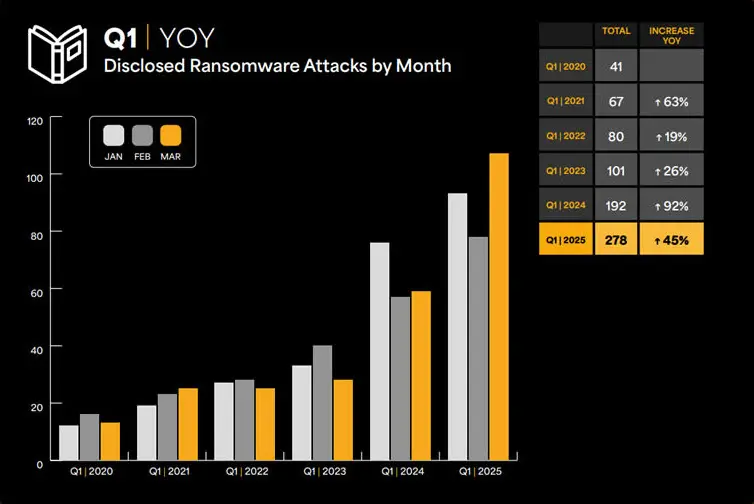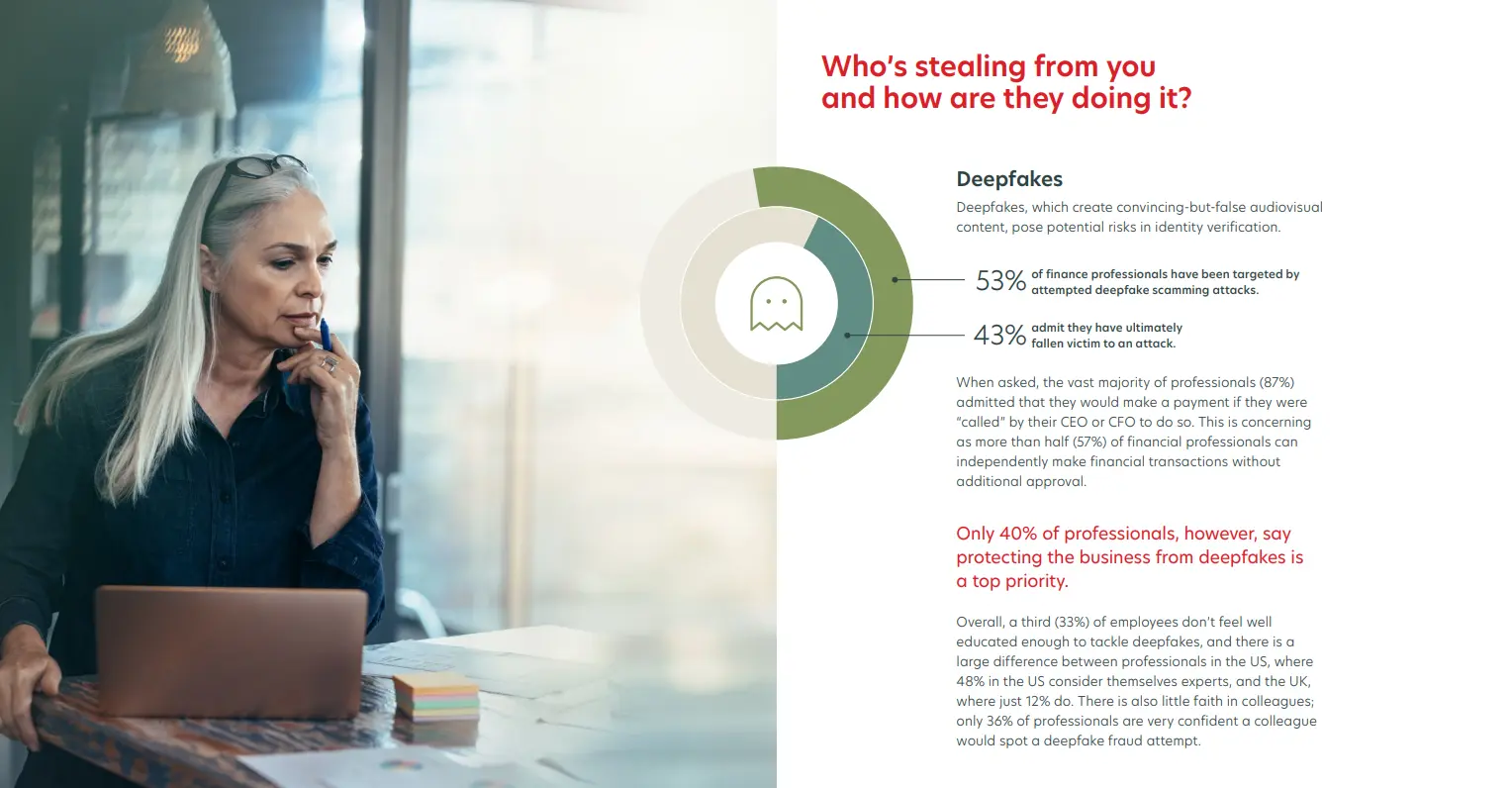Why Most Big Brands Will Face AI Impersonation in 2025
Why Most Big Brands Will Face AI Impersonation in 2025
AI-assisted impersonation is growing significantly, and businesses can no longer afford to ignore it. Cybercriminals are using artificial intelligence to create fake profiles that mimic your employees and brand with frightening accuracy. It’s become so advanced that even security-conscious organizations are falling victim to these attacks.
Today’s attackers can replicate writing styles, create deepfake videos, and write personalized messages that look completely legitimate. That’s why in this blog post, we'll explore what AI impersonation is, why it poses such a significant threat to your business, examine real-world examples of its impact, and provide two actionable strategies to help protect your organization.
What Is AI Impersonation?
AI impersonation happens when attackers use artificial intelligence to create fake profiles of your employees or brand to trick users into believing they are interacting with your official platform.
Modern AI tools allow cybercriminals to study your executives' writing styles, speech patterns, and professional backgrounds to create nearly perfect digital doubles. They can generate realistic profile photos, write personalized messages, and even create convincing video content using deepfake technology.
The attackers' goals vary depending on their specific objectives, but they often use impersonation to…
- Run crypto scams targeting your customers,
- Create fake profiles designed to manipulate your company's stock value,
- Takeover social media accounts to hold them for ransom,
- Launch targeted whaling attacks to steal financial data and trick employees into making unauthorized payments and,
- Execute various other strategies to exploit trust and steal valuable personally identifiable information (PII).
What makes these attacks particularly dangerous is how personalized they are. Attackers can reference real conversations, company events, and professional relationships to create an illusion of legitimacy that's difficult to detect.
Why Is AI Impersonation So Dangerous?
There has been a massive increase in impersonation attacks due to how easy artificial intelligence has made it for criminals to create convincing fake personas. What once required significant technical skills and resources can now be accomplished by anyone with access to basic AI tools and a few hours of preparation.
The democratization of AI technology means that sophisticated impersonation attacks are no longer limited to well-funded criminal organizations. Individual scammers can now create professional-quality fake profiles and personalized attack campaigns with minimal investment.
1) Ransomware Attacks Are Growing Through Social Engineering
One of the most rapidly growing threat vectors is ransomware attacks that begin with AI-assisted social engineering. Attackers are using artificial intelligence to create highly convincing phishing messages distributed through social media and email with the specific purpose of taking over business accounts.
Once they successfully compromise an account, attackers immediately change the email and password to hold the account for ransom. They often demand payment in cryptocurrency and threaten to permanently delete account content or damage your online reputation if their demands aren't met.

What’s most troubling is that data backs up this trend. The BlackFog State of Ransomware 2025 report shows a record-breaking number of ransomware attacks disclosed by victims in Q1, 2025. BlackFog tracked 278 disclosed incidents in Q1, 2025, representing a 45% increase from Q1, 2024. March set a new record with 107 disclosed attacks, following new records set in January and February, which were up 22% and 36% respectively from the previous year.
That's why cybersecurity training should be a priority for every organization, and you should protect your social media presence with monitoring tools specialized in phishing and spam detection. Remember: the cost of prevention is far lower than the price of recovery.
2) There’s Been A Big Increase In Phishing Attacks
It's no surprise that phishing remains the biggest attack vector criminals use to initiate contact with potential victims. According to SlashNext's Phishing Intelligence Report, there was a 202% increase in phishing emails in the second half of 2024.
Given this massive surge in phishing attacks, you might assume that AI is driving most of these campaigns. However, according to Hoxhunt's phishing trends report, only between 0.7% and 4.7% of the phishing emails they analyzed were written entirely by AI.
Now, that doesn’t mean AI isn’t playing a significant role. While AI may not be completely generating most phishing emails, many successful campaigns are likely being improved by AI rather than being completely created by artificial intelligence.
So even though AI-generated phishing emails are still relatively rare in employee inboxes today, they are evolving fast. Each iteration becomes smarter, more convincing, and harder to detect with each passing day.
3) Most Employees Can’t Identify Deepfakes
Deepfake is an acronym that comes from "deep learning" and "fake." The technology uses artificial intelligence to create convincing fake images, audio, and video recordings of real people that can be nearly impossible to distinguish from authentic content.
Editing videos to look real used to be very hard. You needed significant technical expertise and expensive software, but deepfake technology changed that. Now, anyone with basic knowledge and enough time can create convincing deepfakes using readily available tools and tutorials.
What's most troubling is how easily people are fooled. According to research from iProov, while 71% of people globally know what a deepfake is, only 0.1% can consistently identify deepfakes when they encounter them.
As you can see, this creates a huge problem for your organization because if your employees receive a deepfake phishing email or social media message, they most likely won't realize it's not actually you or someone from your leadership team. The psychological impact of seeing and hearing what appears to be a trusted authority figure makes these attacks particularly effective.
The consequences of failing to recognize deepfake content can be very severe, ranging from financial losses to data breaches. That’s why you must make employee training on deepfake detection a top priority for your cyber security program.
4) Whaling Attacks Have Increased Significantly
Since only 0.1% of employees can consistently identify deepfakes, it makes perfect sense that criminals would take advantage of this vulnerability and specifically target high-value executives and decision-makers within organizations.
In fact, the financial industry has become a particularly common target for deepfake attacks. According to a Medius 2024 report, 53% of financial professionals have already experienced attempted deepfake attacks targeting their organizations or personal accounts.

These attacks will continue for as long as they remain profitable for cybercriminals. The combination of AI-generated content and social engineering techniques creates a powerful weapon that's difficult for even security-aware employees to recognize and defend against.
Real Examples of AI Impersonation in Action
There are countless examples of how artificial intelligence is being used to create impersonation attacks, but we'll focus on two particularly interesting cases that show the scale and impact of this growing threat.
Bolster’s Threat Research Findings
Bolster's threat research team discovered a widespread brand impersonation scam campaign targeting more than 100 popular clothing, footwear, and apparel brands including Nike, Puma, Adidas, Casio, and Crocs (just to name a few).
This campaign went live around 2022, and the attackers' goal was to create fake websites using typosquatting techniques that looked identical to the original brand websites. These replicas were designed to steal users' financial information, including login credentials and credit card details, by tricking customers into believing they were shopping on legitimate sites.
The nature of these sites made them extremely difficult for average consumers to identify as fake, resulting in significant financial losses and damaged brand reputation for the targeted companies.
WPP's Executive Deepfake Attack
The CEO of WPP, Mark Read, was targeted by a deepfake scam in May 2024. Attackers used his image and cloned voice to create convincing audio and video content designed to trick employees into believing they were receiving legitimate instructions from their CEO. The attackers attempted to convince WPP employees to set up a new business entity as part of the scheme to solicit money and extract personal details from the organization.
While this particular scam ultimately failed thanks to their employees and proper security protocols, it serves as an excellent example of how AI technology is being weaponized to impersonate leadership. WPP also stated on its website that it had been dealing with fake sites using its brand name and was actively working with relevant authorities to stop the ongoing fraud.
Protecting Your Organization From AI-Generated Impersonation
There are two main strategies you can implement to protect your business from impersonation attacks:
- Regularly train your employees to identify deepfakes and social engineering attempts.
- Deploy specialized technology designed to identify AI-generated content and suspicious activity.
Training your employees to spot deepfakes should be an absolute top priority for your organization. As we discussed above, only 0.1% of employees can consistently identify deepfakes, which represents a massive security vulnerability that you can’t afford to ignore.
Your training program should include regular updates about emerging AI threats, hands-on practice with identifying deepfake content, clear escalation procedures when suspicious content is detected, and ongoing reinforcement of security best practices across all communication channels.
On the technology side, there are many specialized tools you can use to identify AI-generated content and protect your digital presence. For example, you can use social media security tools like Spikerz to monitor for impersonators, protect your business from account takeovers, and spot phishing messages. For your business email, antivirus software often includes features trained to spot AI-generated phishing attempts. It's possible you already have this capability but aren't aware of it.
The key is implementing a layered security approach that combines human awareness with technological protection to create multiple barriers against AI-powered impersonation attacks.
Conclusion
AI impersonation is one of the most significant and rapidly evolving threats facing businesses today. Most big brands will face these attacks, and the sophistication of AI-generated content is advancing faster than most organizations can keep up with.
However, this isn't a hopeless situation. If your businesses implement robust employee training programs, deploy specialized security tools designed for social media protection, and maintain constant vigilance across all digital channels, you’ll build robust defenses against even the most sophisticated impersonation attacks.
The key is taking action now, before you become another statistic in the growing list of victims.



